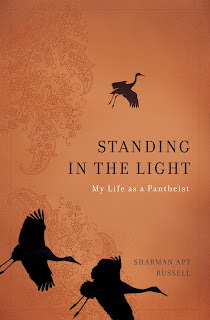 Cranes have always attracted
stories. In the Southwest, the Zunis have a Crane clan to which the Creator gave
the medicine seed of hail and snow, since cranes come during the first winter
storms. The Navajos use a crane effigy to cure illness, and the Hopis place a
crane-winged staff at the entrance to the chamber which represents their
emergence from the earth. Like the Greek god Hermes, with his staff of snakes
topped by crane wings, the crane is linked both to health and the underworld.
Cranes have always attracted
stories. In the Southwest, the Zunis have a Crane clan to which the Creator gave
the medicine seed of hail and snow, since cranes come during the first winter
storms. The Navajos use a crane effigy to cure illness, and the Hopis place a
crane-winged staff at the entrance to the chamber which represents their
emergence from the earth. Like the Greek god Hermes, with his staff of snakes
topped by crane wings, the crane is linked both to health and the underworld.
In Silver City,
the Religious Society of Gila Friends make paper cranes to celebrate Hiroshima
Day, a commemoration of the United
States’ first use of the nuclear bomb. The
Japanese have long revered the crane as a symbol of immortality, and this
modern crane story is about a sick little girl named Sakado who wanted to make
a thousand origami cranes but died first of radiation poisoning.
\
I have no particular story about cranes,
although seeing and hearing them makes me happy. That is true for many wild
animals. I grew up in apartment buildings with Siamese cats and a highly-chlorinated
swimming pool. Cranes are outside my normal experience, outside my personal
joys and sorrows, memories, anxieties and confusion. In my world, cranes are
not about immortality or disease or death. When I watch them, I am not
participating more in being human, I am participating less. Perhaps this is the
cause of my happiness.
I am waiting to see a crane dance.
First, the bird lowers his head while lifting and spreading his wings. The head
rises, the wings stroke down, and the crane jumps up. Sometimes the crane
throws a stick into the air. Now another crane may start jumping, too, facing
the first crane, or standing side by side. According to ornithologists, this
behavior can spread through an entire group of cranes until everyone is dancing,
jumping up and down, wings and heads rising and falling. The point of all this is
unclear. Synchronous dancing is common among birds forming or having just
formed pair bonds. But my husband Peter and our biologist friends Mike and
Carol have seen cranes dance here in the Gila Valley
during winter--when these cranes are finished with nesting and breeding. Dancing,
then, is not just about mating. In a group, dancing can also lead to fighting
or flying and seems related to excitement, stimulation, and a release of energy.
A crane dancing alone would seem so
intent, like a woman doing yoga or a man performing a ritual to his god. A
group of cranes dancing would be a wonderful sight, all that graceful and
ungainly movement. A group of cranes dancing would make me feel special, as
though handed a gift I didn’t deserve but had always coveted. It’s a good
reason to keep my binoculars handy.

No comments:
Post a Comment